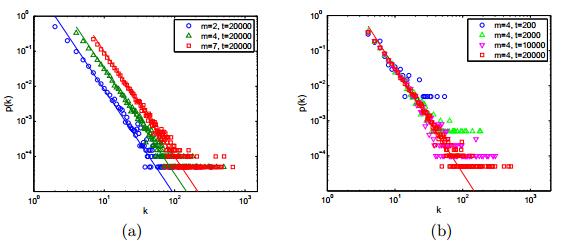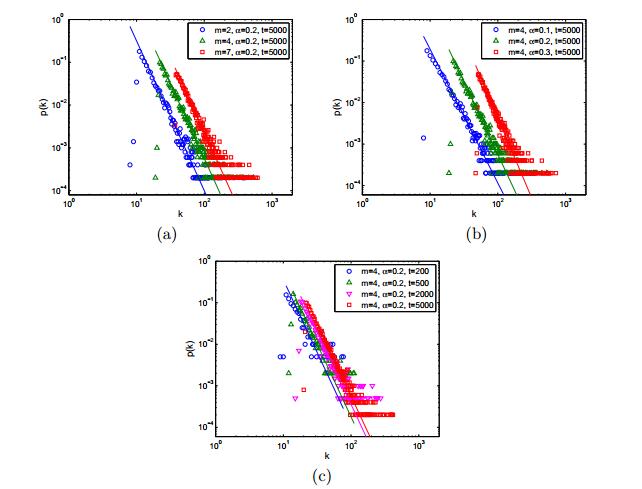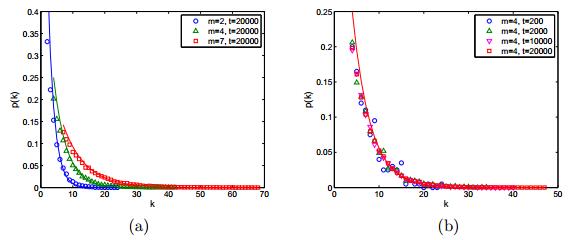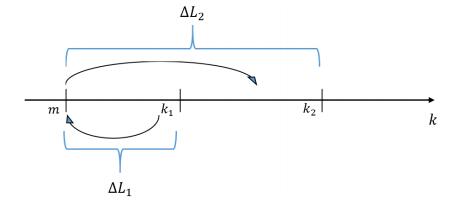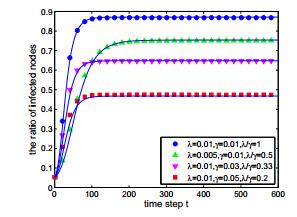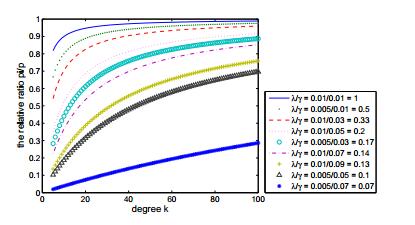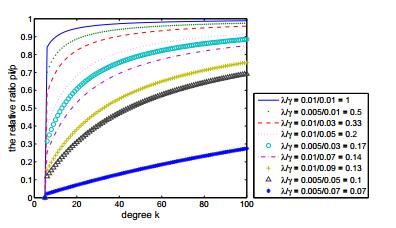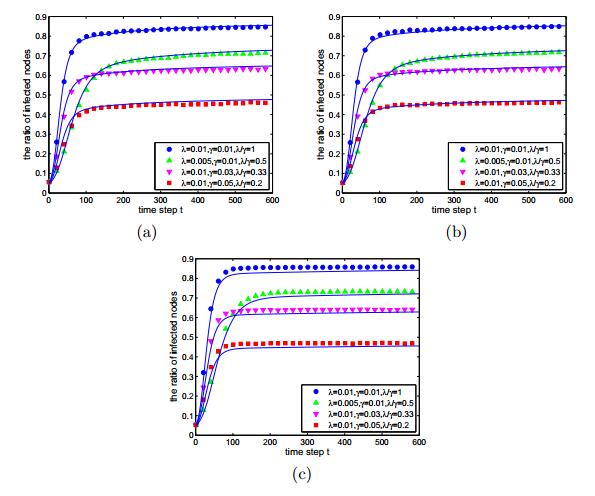1. Introduction
Complex networks are good models for describing and studying complex systems [6,1,21]. It ignores many properties that are not related to the study, and describes the system as a graph containing only nodes and edges, in which nodes represent the elements of the system and edges represent the interactions between them. Some real world networks include the WWW(World Wide Web) networks [8], Internet networks, collaboration networks, citation networks, metabolism networks etc, and some constructed networks include Euler graph, 'small world' network [25], BA network [3], etc.
To study complex networks and their properties, we should first study some basic special quantities characterizing the topology structure of the networks. Traditionally, these characteristic quantities are borrowed from graph theory, such as degree distribution p(k), average degree ⟨k⟩, joint degree distribution p(k1,k2), average path length l, clustering coefficient C, and degree-degree correlation coefficient Ck1,k2, etc. Among them, the degree distribution is the most important topological quantity of the network. Its calculation method mainly includes: the Mean-field method [2], the master equation method [4], the rate equation method [13], and Markov chain-based numerical method [23], etc [5]. The Mean-field method considers degree as continuously changing, and obtains continuous rate of change of ki [2]. Inspired by this idea, here we also use the continuous degree method (CDM). It will transform the network evolution model into a partial differential equation, which can be analysed easily. Using the CDM, we establish a partial differential equation on the cumulative distribution function F(k,t) with the growing network, analytical results of the cumulative distribution function F(k,t) and the degree distribution p(k,t) are obtained. In addition to the degree distribution, the joint degree distribution p(k1,k2) is also another important topology quantity of a network. It is defined as the fraction of directed edges whose nodes have degrees k1 and k2. So far the calculation method of joint degree distribution is mainly the rate equation [14]. In this paper, we calculate the joint degree distribution of BA model by also applying the CDM. As a consequence, we calculate the conditional degree distribution p(k1|k2) and the degree correlation of the networks.
Transmission dynamics on complex networks is another focus of network research. Its dynamical behavior is often influenced by the network topology. Regarding the spread of epidemic, for example, different network topologies often have different threshold and propagation behavior. The main existing epidemic models are node-based model [22,26,0], pairwise models [11,12], effective degree models [15], and edge-based models [20,19,18,24]. Although these models have different styles, they all divide the nodes and edges into different classes according to the node degree. Here we also consider the node degree as a continuous variable, and apply the CDM to establish a continuous degree SIS epidemic model on static BA network. Simultaneously, we also take into account the evolution of the network, and build a continuous degree SIS epidemic model on a BA growing network.
The rest of this paper is organized as follows. In Section 2, applying the CDM, we calculate the degree distribution of three different growing models, which are the BA growing model, the preferential attachment accelerating growing model and the random attachment growing model. In Section 3, we calculate the joint degree distribution of the BA model also using the CDM, and study its degree correlation. In Section 4, we establish a continuous degree SIS model on a static degree uncorrelated network and a BA growing network, respectively. Finally, in Section 5, we conclude the paper.
2. Some calculations of the degree distribution of growing networks with CDM
In this section, we use CDM to calculate the degree distribution of the following three growing models: the BA growing model, the preferential attachment accelerating growing model and the random attachment growing model. The main notations are defined in Table 1.
Table 1. The definition of main notations.
| Notation | Definition |
| m0 | The total number of nodes in the initial network. |
| l0 | The total number of edges in the initial network. |
| Πi | The probability for the node i connect to the new added node. |
| N(t) | The total number of nodes at time t. |
| ˆN(k,t) | The total number of nodes which degree not more than k at time t (note there has a hat hat ˆ on letter N). |
| F(k,t) | The cumulative distribution function of node degree, or the proportion of nodes which degree not more than k, at time t. |
| p(k,t) | The degree distribution, or the probability density of node which degree equal to k, at time t, p(k,t)=∂F(k,t)∂k. |
| L(t) | The total number of directed edges at time t. |
| ˆL(k1,k2,t) | The total number of directed edges which degree sequentially not larger than k1 and k2 at time t (also note the hat). |
| F(k1,k2,t) | The joint cumulative distribution function at time t. |
| p(k1,k2,t) | The joint degree distribution at time t, p(k1,k2,t)=∂2F(k1,k2,t)∂k1∂k2. |
| p(k2|k1,t) | The conditional degree distribution at time t. |
| q(k,t) | The marginal distribution at time t. |
| FS(k,t) | The cumulative distribution function of susceptible nodes at time t. |
| FI(k,t) | The cumulative distribution function of infected nodes at time t. |
| pS(k,t) | The probability density of susceptible nodes which degree equal to k at time t. |
| pI(k,t) | The probability density of infected nodes which degree equal to k at time t. |
| Θk | The probability that a edge emitted by degree k node points to an infected node. |
| Θ | The probability that a edge points to an infected node in degree unrelated network. |
2.1. Calculation of the degree distribution of the BA growing model with CDM
First, we recall the BA model, whose evolution mechanism contains two aspects:
H1: Growth: Starting with a small number (m0) of nodes, we add a new node with m(≤m0) edges at every time step. The node added at ith time step is marked as i.
H2: Preferential attachment: the probability Πi that node i connects to a new node is proportional to its degree ki, i.e., Πi=ki∑jkj.
We consider that the time t and the node degree k change continuously. Let N(t) represent the total number of nodes at time t, ˆN(k,t) represent the number of nodes with degree less than or equal to k at time t. Let F(k,t) represent the cumulative distribution function of network (or the proportion of nodes with degree less than or equal to k) at time t, and let the derivative of F(k,t) with respect to k represent the degree distribution p(k,t), in fact the probability density, at time t. In the continuous degree case, obviously, we have the following relation:
|
ˆN(k,t)=N(t)F(k,t)=N(t)∫k0p(x,t)dx.
|
(1)
|
It's not difficult to find that the growth of the BA model satisfies the Markov property. That is to say, the network structure at time t+Δt depends only on the structure at the most recent time t and does not depend on the history of the evolution. Based on this we can establish the evolution equation for F(k,t).
For a node with degree k(>m) at time t, say node A, because of the addition of the new node and new edges, the degree of node A will become k+θkt at time t+Δt in the continuous degree cases, where θkt=mΔtkΣk is the increased degree of node A. Meanwhile, for those nodes with degree less than node A's degree (equal to k) at time t, their degree is still less than A's degree (k+θkt) at time t+Δt due to the co-evolution of nodes. Taking into account the adding of new nodes, ˆN(k+θkt,t+Δt) includes two parts, the old nodes ˆN(k,t) and the newly added nodes ΔˆN(k,t), so we have the following relation:
|
ˆN(k,t)+ΔˆN(k,t)=ˆN(k+θkt,t+Δt).
|
(2)
|
(2) presents the quantitative relation between ˆN(k,t) and ˆN(k+θkt,t+Δt) at time t and time t+Δt. ΔˆN(k,t) is the newly added nodes with degree less than or equal to k in time Δt. We have ΔˆN(k,t)=Δt, Σk=2(l0+mt) (l0 see Table 1). Substituting these and (1) into (2), we obtain
|
N(t)F(k,t)+Δt=N(t+Δt)F(k+mΔtk2(l0+mt),t+Δt).
|
(3)
|
According to the evolution mechanism of the model, we have N(t)=m0+t. Substituting it into (3), we obtain
|
(m0+t)F(k,t)+Δt=(m0+t+Δt)F(k+mΔtk2(l0+mt),t+Δt).
|
(4)
|
Taking the Taylor expansion for F(k+mΔtk2(l0+mt),t+Δt), retaining only the first order terms of Δt and simplifying, we have
|
mΔtk2(l0+mt)∂F(k,t)∂k+Δt∂F(k,t)∂t+Δt(F(k,t)−1)m0+t=o(Δt).
|
(5)
|
Dividing by Δt on both sides of the above equation, and letting Δt→0, we get the following partial differential equation on F(k,t):
|
mk2(l0+mt)∂F(k,t)∂k+∂F(k,t)∂t+F(k,t)−1m0+t=0,
|
(6)
|
in the feasible region D={(k,t)|k≥m,t≥0}. We know that the degree of the new node added at time t is the minimum degree at that moment, and that the new node is attached with m edges when it is added to the network at time t, so the minimum degree of the nodes is m at that time. Thereby we have following initial and boundary conditions:
|
{F(k,0)=Ψ(k),F(m,t)=0,∀t>0,
|
(7)
|
where, Ψ(k) is the cumulative distribution function of the initial network. Note that this boundary condition defaults the degree k of initial nodes is greater than m. In this way, the calculation of the cumulative distribution function F(k,t) reduces to solving an initial-boundary value problem, which is easier to deal with mathematically. Using the characteristic line method to solve (6), and substituting (7) into the general solution, we can get
|
F(k,t)={1−1m0+t(m0+ml0+m2tk2−l0m), if m≤k≤m(1+mtl0)12;tm0+t+m0m0+tΨ(k(1+mtl0)12), if k>m(1+mtl0)12.
|
(8)
|
This equation means that, for given time t>0, the nodes with degree m≤k≤m(1+mtl0)12 are the newly added t nodes from time 0 to time t, whose degree change depending on the boundary condition, and the nodes with degree k>m(1+mtl0)12 are the initial m0 nodes, whose degree change depending on the initial condition.
Assuming that the derivative of cumulative distribution function Ψ(k) with respect to k is the probability density function p(k,0), then differentiating (8) with respect to k, we get the degree distribution:
|
p(k,t)=∂F(k,t)∂k={2ml0+2m2tm0+tk−3, if m≤k≤m(1+mtl0)12;m0(m0+t)(1+mtl0)12p(k(1+mtl0)12,0), if k>m(1+mtl0)12.
|
(9)
|
As we can see, m0 is a very small number when time t is large enough. If we don't consider the initial m0 nodes this result is very close to 2m2tm0+t1k3 in [2], and both are asymptotically equal to the stationary state 2m2k−3 when time t is large enough. In Figure 1, we show the simulation results and corresponding analytical results with different parameter m and time t, respectively.
We assume p(k,0) satisfies ∫∞mkp(k,0)dk=2l0m0, then with the degree distribution (9), we can calculate the average degree
|
⟨kt⟩=∫∞mkp(k,t)dk=2(l0+mt)m0+t.
|
From this expression, we can easily understand that the average degree ⟨kt⟩ is equal to the ratio of two times the actual number of edges and the total number of nodes. Furthermore, the average degree ⟨kt⟩ is approximately equal to 2m when time is large enough.
2.2. Calculation of the degree distribution of the preferential attachment accelerating growing model with m-varying with CDM
Different from BA model, many real networks exhibit accelerating growth, such as the Internet and WWW [8,23,5,9], where the edge number grows faster than the nodes numbers. Here we use the CDM to calculate the degree distribution of one preferential attachment accelerating growing model with m-varying.
Let mtα be the new edge number attached with the new node added at time t, 0≤α<1. That means the new node added at time t will connect to mtα different existing nodes. The rest of the evolution mechanism remains the same as the BA model described in Section 2.1. Similar to the analysis in Section 2.1, the cumulative distribution function F(k,t) satisfies the following relation from time t to t+Δt:
|
N(t)F(k,t)+Δt=N(t+Δt)F(k+θkt,t+Δt),
|
(10)
|
where θkt=∫t+ΔttmxαdxkΣk≃(α+1)kΔt2t. Substituting this into (10) and taking the Taylor expansion, we get
|
(α+1)k2t∂F(k,t)∂k+∂F(k,t)∂t+F(k,t)−1m0+t=0,
|
(11)
|
in the feasible region D={(k,t)|k>mtα,t>0}. For degree k(>mtα) nodes, the coefficient (α+1)k2t in (11) can be regarded as the changing rate of degree over time t. And this rate of change is larger than the add rate of new node (mtα)′=αmtα−1, since 0≤α<1. So the minimum degree of the nodes is mtα which is the degree of new added node at time t. Thus, the boundary condition will be
Solving this boundary problem, we obtain
|
F(k,t)=1−1m0+t(m0+(km)2α−1t1+α1−α).
|
(13)
|
Consequently, the degree distribution is
|
p(k,t)=∂F(k,t)∂k=2(m0+t)(1−α)m21−αt1+α1−αk−3−α1−α≈21−αm21−αt2α1−αk−3−α1−α.
|
(14)
|
This result is completely equivalent to (24) in [23]. The simulation results and analytical results are showed in Figure 2.
2.3. Calculation of the degree distribution of the random attachment growing model with CDM
In this subsection, we will calculate the degree distribution of random attachment growing model using CDM. Same as the BA model, the random attachment growing model also starts with a small number (m0) of nodes, and add a new node with m(≤m0) edges at every time step. But the difference is that the newly added node in this model is randomly connected with the old ones. That is to say, for one edge the probability each old node be chosen to connect is the same, equal to 1N(t).
Similar to the BA growing model, we also have the following relationship on cumulative distribution function F(k,t)
|
N(t)F(k,t)+Δt=N(t+Δt)F(k+θkt,t+Δt),
|
(15)
|
where θkt=mΔt1N(t)=mΔtm0+t. Substituting this into (15) and dealing with it using the same processing method as Section 2.1 and 2.2, we get
|
mm0+t∂F(k,t)∂k+∂F(k,t)∂t+F(k,t)−1m0+t=0,
|
(16)
|
also in the feasible region D={(k,t)|k>m,t>0}. As the same with BA model, this partial differential equation has the initial and boundary conditions (7).
Solving (16), and substituting (7) into the general solution, we get
|
F(k,t)={1−e1−km,m<k≤m+ln(m0+tm0)m;tm0+t+m0m0+tΨ(k+ln(m0m0+t)m),k>m+ln(m0+tm0)m.
|
(17)
|
If we ignore the initial m0 nodes, the degree distribution is
|
p(k,t)=∂F(k,t)∂k=1me1−km,m<k≤m+ln(m0+tm0)m.
|
(18)
|
This result is the same as the (17) in [2], which verifies the accuracy of CDM again. In Figure 3, we show the simulation results as well as analytical results.
3. Calculation of the joint degree distribution of the BA growing model with CDM
In Section 2, we have shown that the CDM can be used to calculate the degree distribution of some growing models. In this section, with the help of the CDM, we will calculate the joint degree distribution of BA model.
Assume that the edges have direction, so the total number of directed edges, written as L(t)=2(l0+mt), is twice the number of actual edges. The joint degree distribution p(k1,k2) here we study is the fraction of directed edges that connect nodes of degree k1 and degree k2.
In the continuous degree case, let ˆL(k1,k2,t) represent the total number of directed edges whose degrees are sequentially not larger than k1 and k2 at time t, let F(k1,k2,t) represent the joint cumulative distribution function at time t, namely, the proportion of directed edges whose degrees are sequentially not larger than k1 and k2 at time t. It is well known that the second order partial derivative p(k1,k2,t) of joint cumulative distribution function sequentially with respect to k1 and k2 represents the joint degree distribution, actually the joint probability density. So we have the following relations:
|
ˆL(k1,k2,t)=L(t)F(k1,k2,t),
|
(19)
|
|
F(k1,k2,t)=∫k10∫k20p(x1,x2,t)dx1dx2.
|
(20)
|
For a directed edge which from one node with degree k1 point to another node with degree k2 at time t, due to the addition of new nodes and new edges, the degrees of its two nodes sequentially will be k1+θk1t and k2+θk2t at time t+Δt. Therefore, similar to the thought of degree distribution, the ˆL(k1+θk1t,k2+θk2t,t+Δt) consists of the old directed edges ˆL(k1,k2,t) and some newly added directed edges ΔˆL(k1,k2,t) whose degrees are sequentially not larger than k1 and k2, namely,
|
ˆL(k1,k2,t)+ΔˆL(k1,k2,t)=ˆL(k1+θk1t,k2+θk2t,t+Δt).
|
(21)
|
Substituting (19) into (21), we have
|
L(t)F(k1,k2,t)+ΔˆL(k1,k2,t)=L(t+Δt)F(k1+θk1t,k2+θk2t,t+Δt),
|
(22)
|
where, θkt, as described in Section 2, is the increased degree of the node at time t+Δt whose degree is k at time t. ΔˆL(k1,k2,t) is consists of two parts, shown in Figure 4, one part is the directed edges which point to the new node, denoted as ΔL1. ΔL1 is equal to the accumulation number of new edges connected nodes with degree from m to k1. The other part is the directed edges emitted by the new node, denoted as ΔL2. Similar to ΔL1, ΔL2 is equal to the accumulation number of new edges connected nodes with degree from m to k2. So we have the expression ΔˆL(k1,k2,t)=ΔL1+ΔL2. Where
|
ΔL1=mΔt∫k1mkN(t)p(k,t)dk∫∞mkp(k,t)N(t)dk,
|
(23)
|
and
|
ΔL2=mΔt∫k2mkN(t)p(k,t)dk∫∞mkp(k,t)N(t)dk.
|
(24)
|
In the above two equations, mΔt represents the number of added directed edges which are point to or emitted by the new node. ΔL1 and ΔL2 are piecewise functions due to the p(k,t) is a piecewise function. Now we only calculate the directed edges between the young nodes, m<k1,k2≤m(1+mtl0)12, which are added in the process of the evolution of the network not the initial nodes.
Substituting L(t)=2(l0+mt), N(t)=m0+t, (9), (23) and (24) into (22), we have
|
2(l0+mt)F(k1,k2,t)+mΔt(2−mk1−mk2)=2(l0+mt+mΔt)F(k1+θk1t,k2+θk2t,t+Δt),
|
(25)
|
where θkit=mΔtki2(l0+mt), i∈1,2. Taking the Taylor expansion for the right side of (25), both sides divided by Δt, and let Δt→0, finishing
|
mk12(l0+mt)∂F(k1,k2,t)∂k1+mk22(l0+mt)∂F(k1,k2,t)∂k2+∂F(k1,k2,t)∂t+ml0+mt(F(k1,k2,t)+m2k1+m2k2−1)=0,
|
(26)
|
in the feasible region D={(k1,k2,t)|m<k1,k2≤m(1+mtl0)12,t>0}. And the boundary conditions is
|
{F(k1,m,t)=0,∀t>0,m<k1≤m(1+mtl0)12,F(m,k2,t)=0,∀t>0,m<k2≤m(1+mtl0)12.
|
(27)
|
Using the characteristic line method to solve this boundary value problems, we get
|
F(k1,k2,t)=1−mk1−mk2+m2k1k2.
|
(28)
|
This joint cumulative distribution function applies only to the directed edges between the young nodes. The proportion of these directed edges to the total directed edges is F(m(1+mtl0)12,m(1+mtl0)12,t), which is equal to (1−(l0l0+mt)12)2, and this result tends to 1 when the time t is large enough. So (28) can be seen as the joint cumulative distribution function of the total directed edges on the steady state.
Differentiating the (28) sequentially with respect to k1 and k2, we obtain the joint degree distribution
|
p(k1,k2,t)=∂2F∂k2∂k1=m2k21k22.
|
(29)
|
From (29) we can see that the joint degree distribution p(k1,k2,t) does not contain the time variable t, that is to say, the joint degree distribution does not vary over time t. So we denote p(k1,k2,t) as p(k1,k2).
For the joint degree distribution in (29), it is easy to verify that p(k1,k2) satisfies the following three properties:
1. Symmetry, namely
|
p(k1,k2)=p(k2,k1),∀k1,k2≥m,
|
(30)
|
2. Normalization, namely
|
∫∞m∫∞mp(k1,k2)dk2dk1=1,
|
(31)
|
3. Marginal distribution, namely
|
q(k2)=∫∞mp(k1,k2)dk1=mk22,
|
(32)
|
where m denotes the minimum of node degrees. The marginal distribution q(k) can be defined as the probability that a randomly chosen neighbor of a randomly chosen node will have degree k. q(k) can be also regarded as the fraction of directed edges which send out by nodes of degree k. In general, the marginal distribution q(k) is different from the degree distribution p(k).
Now, we consider the conditional degree distribution p(k2|k1,t), which is defined as the probability that a randomly chosen neighbor of a node of degree k1 have degree k2. From (9) and (29), we have
|
p(k2|k1,t)=⟨kt⟩p(k1,k2,t)k1p(k1,t)=mk22.
|
(33)
|
From (33), we know that in BA growing network the conditional degree distribution p(k2|k1) does not depend on the start nodes of degree k1, only relates to the point nodes of degree k2, and is equal to the marginal distribution of degree k2 node q(k2). So we say the BA model has no degree correlations.
Next, we study the degree correlation of BA model by using the assortativity coefficient Ck1,k2=⟨k⟩N[k1k2]k1[k1]k2[k2] in [10], which compares the true number of pairs of a given degree with the expected number of pairs connected at random. In the case of continuous degree, [k1k2] represents the true density of pairs of k1 -k2 node, which equals to L(t)p(k1,k2). [k] represents the node density of degree k, which equals to N(t)p(k,t). Substituting these into Ck1,k2, we have
|
Ck1,k2=⟨k⟩N[k1k2]k1[k1]k2[k2]=1.
|
(34)
|
From (34) we can get that the edge number of k1 -k2 pairs connected at random is equal to the actual number of edges. In other words, the BA networks have no degree correlations, which is of great significance in the study of network spreading dynamics.
4. The SIS model on degree uncorrelated networks based on the CDM
In addition to the structure of the network, we will use the CDM to study the epidemic spreading on static and growing networks, respectively.
4.1. The SIS model on static network
In order to establish a continuous degree SIS model on a static degree uncorrelated network, first, let each node exist only in two discrete states, susceptible or infected. We use ˆNS(k,t) and ˆNI(k,t) to represent the number of susceptible nodes and infected nodes whose degree is less than or equal to k at time t. We use FS(k,t) and FI(k,t) to represent the cumulative distribution functions of susceptible nodes or infected nodes at time t. Thus their partial derivatives with respect to variable k, pS(k,t) and pI(k,t), represent the probability density of susceptible nodes or infected nodes at time t, respectively, namely the degree distribution. pS(k,t) or pI(k,t) can be regarded as the probability that a node randomly selected with degree k and is susceptible or infected. They satisfy the following relations:
|
ˆN(k,t)=ˆNS(k,t)+ˆNI(k,t),
|
(35)
|
|
ˆNS(k,t)=N(t)FS(k,t),
|
(36)
|
|
ˆNI(k,t)=N(t)FI(k,t),
|
(37)
|
|
FS(k,t)=∫k0pS(x,t)dx,
|
(38)
|
|
FI(k,t)=∫k0pI(x,t)dx.
|
(39)
|
Then we consider the spread mechanism. At each time step, one susceptible node becomes infected node due to the contact with the infected neighbors, and the probability of each contact and infection with infected nodes is λ. At the same time, each infected node is cured and becomes susceptible state again with probability γ.
The epidemic spreading also satisfies the Markov property. So from time t to time t+Δt, the state transition of pS(k,t) and pI(k,t) can be expressed as follows:
|
{pS(k,t+Δt)=γΔtpI(k,t)+(1−λkΘkΔt)pS(k,t),pI(k,t+Δt)=(1−γΔt)pI(k,t)+λkΘkΔtpS(k,t),
|
(40)
|
where, γΔt is the recovery rate of infected nodes in time Δt, and (1−λkΘkΔt) is the rate of not being infected of susceptible nodes in time Δt. Θk=∫∞0p(x|k,t)pI(x,t)p(x,t)dx is the probability that an edge emitted by degree k node points to an infected node. In a degree uncorrelated network, say, the BA network, the Θk will be Θ=1⟨k⟩∫∞0xpI(x,t)dx. Transforming (40) and dividing by Δt both sides, then let Δt→0, we get
|
{∂pS(k,t)∂t=−λkΘpS(k,t)+γpI(k,t),∂pI(k,t)∂t=λkΘpS(k,t)−γpI(k,t).
|
(41)
|
This is the continuous degree SIS model on degree uncorrelated static networks. This model is corresponding to the discrete degree SIS model established by R. Pastor-Satorras and A. Vespignani in [22]. The essential difference is that the variable k in this model is a continuous variable, but in other model variable k is a discrete variable. So the range of variable k in this model is the positive real numbers, not only positive integers.
Similar to the discrete degree SIS model, the spread threshold of epidemic is also equal to c=λ⟨k2⟩γ⟨k⟩. This means that if c<1, the disease dies out, otherwise the disease spreads. On the BA static network this threshold is infinite, i.e., small amount of infected nodes can cause the outbreak of epidemics.
It is very difficult to obtain the analytical solution of (41). Take the BA static network as an example, we perform the simulations. As depicted in Figure 5, the stochastic simulations are in good accord with the numerical simulations. In Figure 5, We can also see that the smaller the ratio λγ, the smaller the infected proportion at steady state. This is obvious because both the small infected rate λ and the big recovery rate γ can prevent the spread of epidemic.
It is shown in Figure 6 that for a node the greater the degree, the greater the probability of being infected. This is easy to understand that the big degree nodes have more neighbors, so the infected neighbors are more, thus the ratio of infected will increase.
4.2. The SIS model on BA growing network
It is well known that many networks in reality are evolving constantly, not in the static state, such as the WWW and friends networks, which exist the addition or extinction of nodes and the disconnection or rewiring of edges. At the same time, the spread of epidemic is entangled with the network evolution. And the spread is also influenced by the network evolution. In this subsection we use the CDM to study the special BA growing network whose growth along simultaneously with the spread of epidemic, and establish the continuous degree SIS model on a BA growing network.
The evolution mechanism of growing network consists of three parts: the H1 H2 in Section 2.1 and the following H3. Note that the nodes before the time step t0 are the susceptible, and the new nodes added at every time step are also the susceptible.
H3: Epidemic Spread: at time step t0, there appears infected nodes. From this time on, the epidemic is propagated. namely there not only have the addition of new node to the network, but also have the epidemic spread. And the spread mechanism of epidemic is the same as the Section 4.1.
From the above evolution mechanism, we can know that before the time step t0 this network is the same as the BA network. But after time step t0, there appears the spread of epidemic. Therefore, we only study the network after time step t0.
The notation ˆNS(k,t) and ˆNI(k,t) are the same as the Section 4.1. Let ˆLSk(t) represent the number of directed edges which from susceptible ˆNS(k,t) nodes point to infected nodes at time t, ˆLSk(t)=N(t)∫kmpS(x,t)xΘdx where Θ is as described in Section 4.1. Based on (2), we consider the node state and the spread of epidemic, and exist
|
{ˆNS(k,t)−ΔtλˆLSk(t)+ΔtγˆNI(k,t)+Δt=ˆNS(k+θkt,t+Δt),ˆNI(k,t)+ΔtλˆLSk(t)−ΔtγˆNI(k,t)=ˆNI(k+θkt,t+Δt).
|
(42)
|
Substituting (36), (37), and ˆLSk(t)=N(t)∫kmpS(x,t)xΘdx into (42), we get
|
{N(t)FS(k,t)−ΔtλN(t)∫kmpS(x,t)xΘdx+ΔtγN(t)FI(k,t)+Δt=N(t+Δt)FS(k+θkt,t+Δt),N(t)FI(k,t)+ΔtλN(t)∫kmpS(x,t)xΘdx−ΔtγN(t)FI(k,t)=N(t+Δt)FI(k+θkt,t+Δt).
|
(43)
|
Taking the Taylor expansion for the right-hand side of this equations, both sides of equations divided by ΔtN(t), then let Δt→0, we obtain
|
{mk2(l0+mt)∂FS(k,t)∂k+∂FS(k,t)∂t+FS(k,t)−1m0+t+λ∫kmxps(x,t)Θdx−γFI(k,t)=0,mk2(l0+mt)∂FI(k,t)∂k+∂FI(k,t)∂t+FI(k,t)m0+t−λ∫kmxps(x,t)Θdx+γFI(k,t)=0.
|
(44)
|
The sum of two equations in (44) is
|
mk2(l0+mt)∂(FS+FI)∂k+∂(FS+FI)∂t+(FS+FI)−1m0+t=0.
|
(45)
|
Where FS is short for FS(k,t), and FI is the same. This equation is the same as (6) of BA growth without considering the nodes states. So we can know that p(k,t) is the sum of pS(k,t) and pI(k,t) according to Section 2.
(44) contains the variables pS(k,t),pI(k,t),FS(k,t),FI(k,t). In order to close the equations, we differentiate the equations both sides with respect to k, and get
|
{mk2(l0+mt)∂pS(k,t)∂k+∂pS(k,t)∂t=−λΘkpS(k,t)+γpI(k,t)−(m2(l0+mt)+1m0+t)pS(k,t),mk2(l0+mt)∂pI(k,t)∂k+∂pI(k,t)∂t=λΘkpS(k,t)−γpI(k,t)−(m2(l0+mt)+1m0+t)pI(k,t),
|
(46)
|
where Θ=1⟨k⟩∫∞mxpI(x,t)dx. These differential-integral equations are the continuous degree SIS model on the BA growing network, they describe the evolution of degree distribution of susceptible and infected, respectively. According to the evolution mechanism of the network, we can know that the newly added node is susceptible, not the infected. Therefore, we have the following initial-boundary value conditions:
|
{pI(k,t0)=p∗I(k),pS(k,t0)=p(k,t)−p∗I(k),pI(m,t)=0,∀t>t0,pS(m,t)=p(m,t),∀t>t0.
|
(47)
|
As described in Section 4.1, the spread threshold of epidemic on static BA network is infinite, so the spread threshold of epidemic on BA growing network is also infinite if the growth is not very fast, namely, small amount of infected nodes can also cause the outbreak of epidemic.
Solving analytically these equations is difficult, so we perform the following simulation. In Figure 7, we find that the big degree nodes have a relatively high probability of being infected, pI(k,t)p(k,t), this is the same as the epidemic spread on static BA network.
As depicted in Figure 8, the newly added health nodes can slightly reduce the ratio of infected nodes, but the final ratio of infected nodes will gradually tend to the final ratio of infected nodes of SIS model on static network. This result can also be obtained from (46), because that when time t tends to infinity the autonomous system (46) will become non-autonomous system (41). In Figure 8(a) and 8(b), we can see after about 100 time steps that infected ratio will slowly rise, but in Figure 8 (c) the rise is not obvious. Hence, the larger the epidemic occurrence time t0, the smaller the influence of network growth to the epidemic spread.
5. Conclusion
When a network reaches certain size, the node degree can be considered as a continuous variable, so we put forward the CDM to calculate the degree distribution. Using the CDM we calculate the degree distribution of the three growing models, which are the BA growing model, the preferential attachment accelerating growing model with m-varying and the random attachment growing model. Moreover, we also use CDM to calculate the joint degree distribution p(k1,k2) of the BA growing model, the result reveals that the BA model has no degree correlations. In addition, the continuous degree SIS models on the static and growing networks are established via CDM.
Although the analytical solution of PDEs is usually difficult to obtain, there is some advantages of CDM, i.e., we can transform the evolution of network into a partial differential equation(s) on cumulative distribution function or probability density function, thus we can study analytically the structure of networks and the spread of epidemic on them.
In this paper, we use the CDM to calculate the topology structure of networks and establish the epidemic models on these networks. However, the evolution mechanism of networks in reality is very complicated. For example, a network may exist the addition or extinction of nodes, the disconnection or rewiring of edges, or even the both. When considering the state of nodes, the evolution of the nodes and edges may depend on the state of nodes, which are likely to occur in a real social network. E. g., the susceptible individuals may break the connection with infected, or rewire with other susceptible. Thus, with the CDM we will consider the following problems: (1) which topological structure can also be studied; (2) When we consider the state of nodes and the evolution mechanism of networks, how should we build the model in this case.
Acknowledgments
It is a pleasure to thank professor Zhenchao Han of Rutgers University for modification and guidance. This work was supported by National Natural Science Foundation of China under Grant Nos.11331009,11171314, TianYuan Special Foundation of the National Natural Science Foundation of China (11226259), Research Project supported by Shanxi Scholarship Council of China (2013-3), outstanding creative team of colleges and universities in Shanxi Province No. 232548901001, and sci-tech innovation team in Shanxi Province "The spread of infectious diseases prevention and control" No. 2015013001-06.









 DownLoad:
DownLoad: 